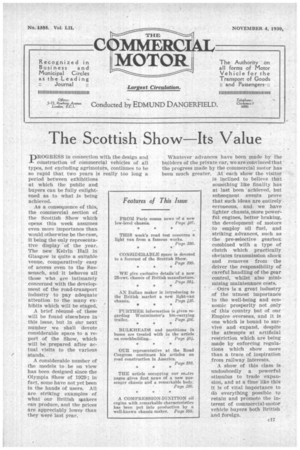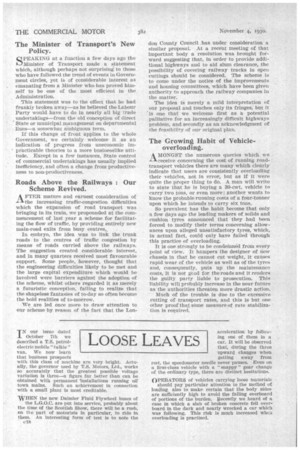The Scottish Show—Its Value
Page 47

Page 48

If you've noticed an error in this article please click here to report it so we can fix it.
PROGRESS in connection with the design and construction of commercial vehicles of all types, not excluding agrimotors, continues to be so rapid that two years is really too long a period between exhibitions at which the public and buyers can be fully enlight ened as to what is being achieved.
As a consequence of this, the commercial section of the Scottish Show which opens this week assumes even more importance than would otherwise be the case, It being the only representative display of the year. The new Kelvin Hall in Glasgow is quite a suitable venue, comparatively easy of access even to the Sassenach, and it behoves all those who are intimately concerned with the development of the road-transport industry to pay adequate attention to the many exhibits which Will be staged.
A brief résumé of these will be found elsewhere in this issue, but in our next number we shall devote considerable space to a report of the Show, which will be prepared after actual visits to the various stands.
A considerable number of the models to be on view has been designed since the Olympia Show of 129; in fact, some have not yet been in the hands of users. All are striking examples of what our British naakers can produce, and the prices are appreciably lower than they were last year. . Whatever advances have been made by the builders Of the private ear, we are convinced that the progress made by the commercial Motor has been much greater. At each show the visitor is inclined to believe that something like finality has at last been 'achieved, but subsequent events prove that such ideas are entirely' erroneous, and: we have lighter, chassis, More powerful engines, better braking, the development of motors to employ oil fuel, and striking advances, such as the pre-selective gearbox combined with a type of clutch which practically obviates transmission shock and removes from the driver the responsibility of careful handling of the gear control, whilst also minimizing Maintenance costs.
Ours is a great industry of the utmost importaiMe to the well-being and economic prosperity not only of this country but of our Empire overseas, and it is one which is bound to survive and expand, despite the attempts at artificial restriction which are being made by enforcing regulations which show more than a trace of inspiration from railway interests.
A show of this class is undoubtedly a powerful stimulus to trade expansion, and at a time like this it is of vital importance to da everything possible to retain and promote the interest of commercial-motor vehicle buyers both British and foreign.
The Minister of Transport's New Policy.
QPEAKING at a function a few days ago the k-.3141inister of Transport made a statement which, although perhaps not surprising to those who have followed the trend of events in Government circles, yet is of considerable interest as emanating from a Minister who has proved himself to be one of the most efficient in the Administration.
This statement was to the effect that he had frankly broken away—as he believed the Labour Party would have to do in nearly all big trade undertakings—from the old conception of direct State or municipal management on departmental lines—a somewhat ambiguous term.
If this change of front applies to the whole Government, we certainly welcome it as an indication of progress from uneconomic inpracticable theories to a more businesslike attitude. Except in a few instances, State control of commercial undertakings has usually implied inefficiency, and often a change from productiveness to non-productiveness.
Roads Above the Railways : Our Scheme Revived.
A FTER mature and earnest consideration of -Cm-the increasing traffic-congestion difficulties which the expansion of road transport was bringing in its train, we propounded at the commencement of last year a scheme for facilitating the flow of traffic, by providing entirely new main-road exits from busy centres._ In embryo, the idea was to link the trunk roads to the centres of traffic congestion by means of roads carried above the railways. The suggestion created considerable interest, and in many quarters received most favourable support. Some people, however, thought that the engineering difficulties likely to be met and the large capital expenditure which would be involved were barriers against the adoption of the scheme, whilst others regarded it as merely a futuristic conception, failing to realize that the shapeless fantasies of to-day so often become the bold realities of to-morrow.
We are led once more to draw attention to our scheme by reason of the fact that the Lou don County Council has under consideration a similar proposal. At a recent meeting of that 'Important body a resolution was brought forward suggeSting that, in order to provide additional highways and to aid slum clearance, the possibility of covering railway tracks in open' cuttings should be considered. The scheme is to come under the notice of the improvements and housing committees,. which have been given authority to approach the railway companies in the matter.
The -idea ismerely a mild interpretation of our proposal and touches only its fringes, but it is one that we welcome first as a potential • palliative for an increasingly difficult highways . problem, and secondly as an acknowledgment of the feasibility of our original plan.
The Growing Habit of Vehicleoverloading.
A MONGST the numerous queries which we La-receive concerning the cost of running roadtransport vehicles there are many which clearly indicate that users are consistently overloading their vehicles, not in error, but as if it were quite the proper thing to do. A man will write to state that he is buying a 30-cwt. vehicle to carry' two tOns, or even more; another wants to know the probable running costs of a four-tonner upon which he intends to carry six tons.
So prevalent has the habit become that only a few days ago the leading makers of solids and cushion tyres announced that they had been forced to modify their terms concerning allowances upon alleged unsatisfactory tyres, which, in actual fact, could only have failed through this practice of overloading. "
It is one strongly to be condeinned from every Point of view. It hampers the designer of new -chassis in that he cannot cut weight, it causes rapid wear of the vehicle as well as of the tyres and, consequently, puts up the maintenance costs, it is not good for the roads and It renders the guilty party liable to prosecution. This U ability will probably increase in the near future as the authorities threaten more drastic action. Much of the trouble is due to the excessive cutting of transport rates, and this is but one other proof that some measure of rate stabilization is reouired.




























































































































